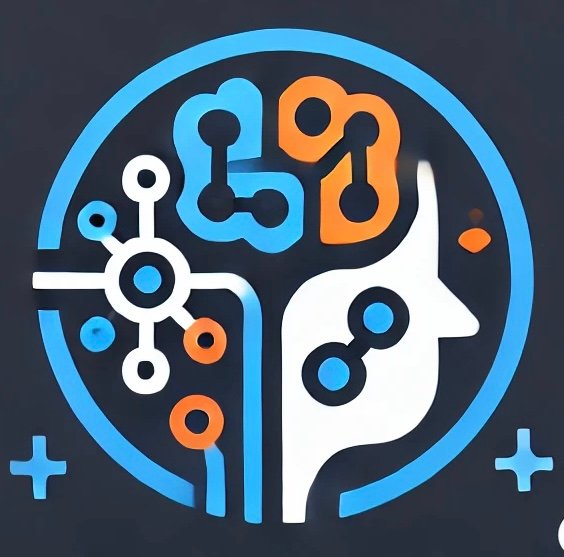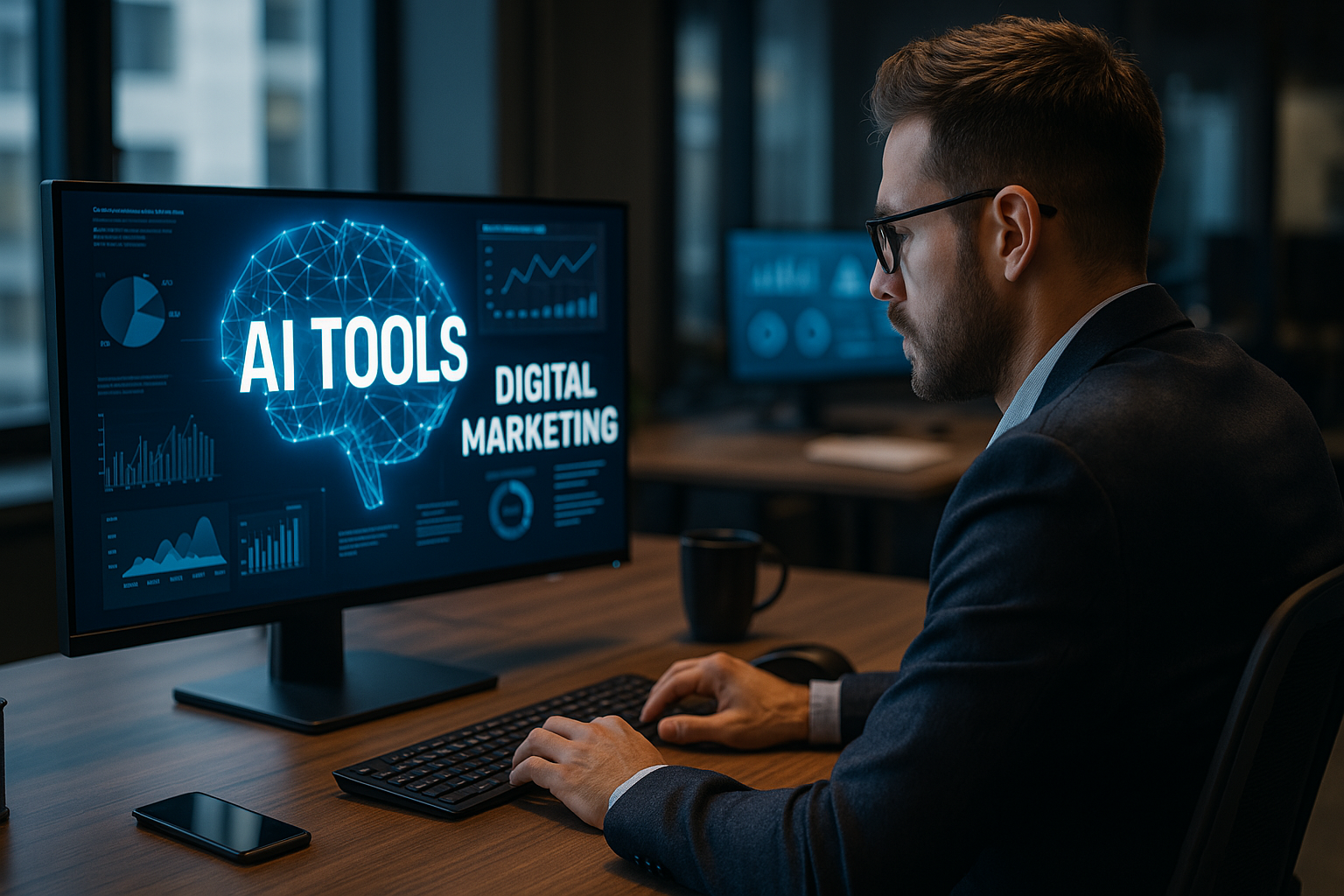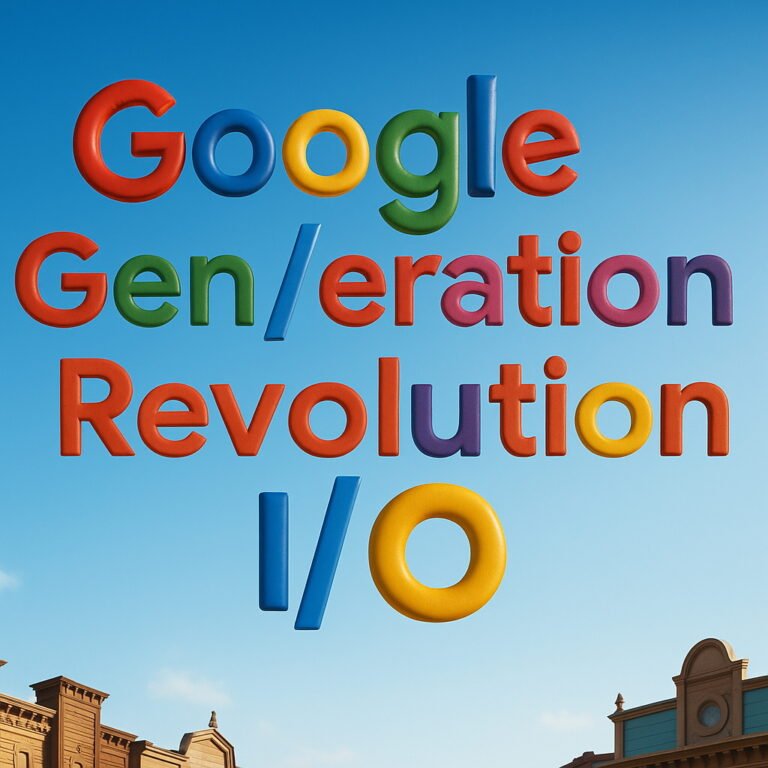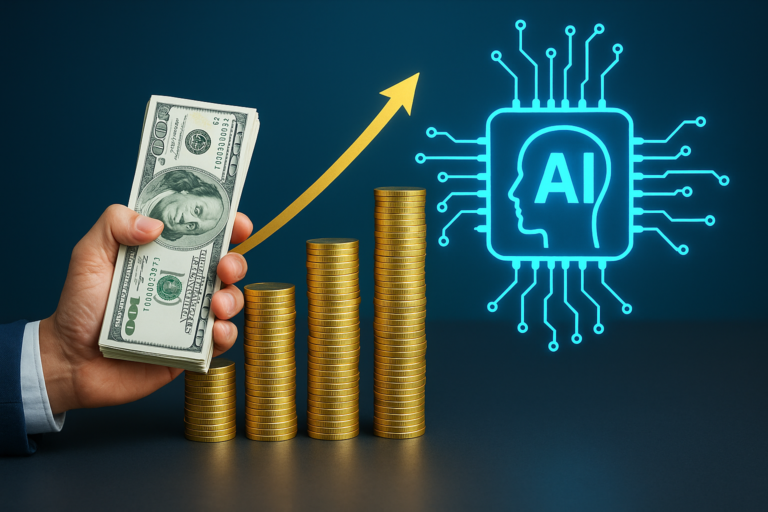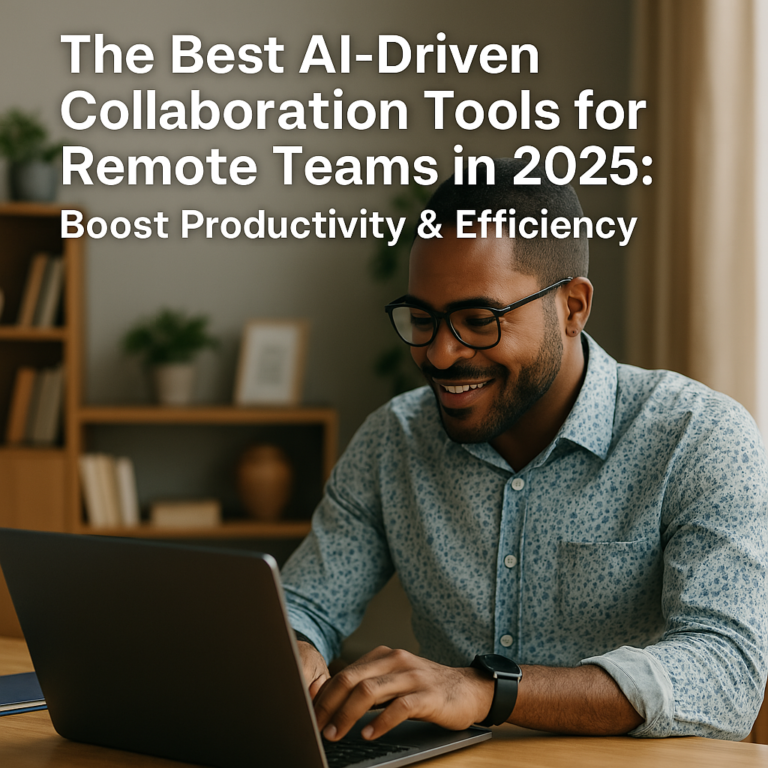INTRODUCTION
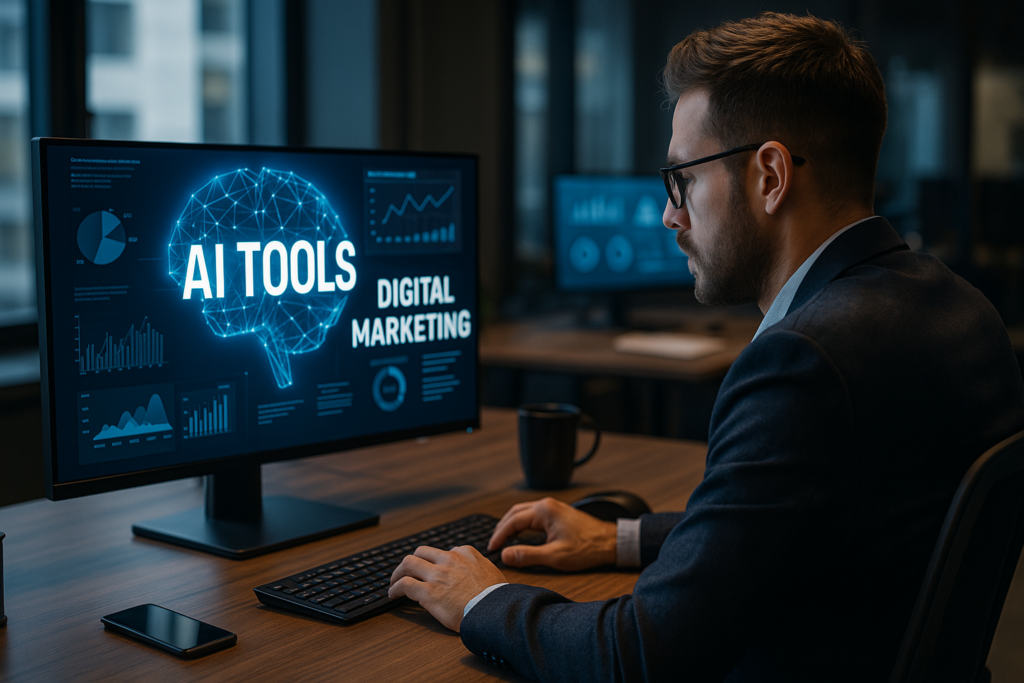
Step into a marketing department from just five years ago, and you’d find teams manually crunching numbers, crafting ad copy by instinct, and juggling social media posts without automation. Fast forward to 2024, and that old-school approach feels almost prehistoric.
Today, artificial intelligence is at the heart of digital marketing innovation. From generating high-converting content to forecasting consumer behavior with pinpoint accuracy, the best AI tools for digital marketers 2025 have shifted from being nice-to-have extras to mission-critical assets.
In a world where competition is fierce and attention spans are short, marketers not using AI are falling behind. Recent McKinsey research reveals that companies embracing AI in their marketing strategies are outperforming their peers by up to 30% in revenue growth.
In this guide, we’ll break down the best-performing AI tools of 2024—how they work, what problems they solve, and how you can use them to elevate your strategy, streamline your workflow, and drive real results.
Table of Contents
Background & Importance
What Role Do the Best AI Tools for Digital Marketers in 2024 Play?
The best AI tools for digital marketers in 2024 are redefining what’s possible in the world of marketing. At their core, these tools leverage artificial intelligence to automate, optimize, and enhance every stage of the marketing process. From simplifying repetitive tasks to unlocking deep insights from complex data, AI is no longer just a buzzword—it’s a powerful driver of performance and growth.
Over the years, AI in marketing has evolved dramatically. What once started as basic rule-based automation has now transformed into highly intelligent systems that can:
- Understand natural language and user intent
- Generate high-quality, human-like content
- Predict consumer behavior with surprising accuracy
- Deliver personalized experiences in real-time
- Automatically analyze and optimize campaigns for better ROI
These capabilities are what make the best AI tools so essential for digital marketers looking to stay ahead in 2024’s fast-paced digital landscape.
The Impact of AI on Marketing Strategies
AI-driven marketing software has fundamentally changed how we approach marketing strategy. Traditional marketing relied heavily on historical data, creativity, and human intuition. While these elements remain important, AI adds a layer of precision and efficiency that was previously impossible.
According to Salesforce’s State of Marketing report, 84% of marketers now use AI in some capacity, up from just 29% in 2018. This dramatic increase reflects how AI is reshaping core marketing functions:
- Data Analysis: AI can process and derive insights from massive datasets in seconds, identifying patterns humans might miss.
- Customer Journey Mapping: AI helps track and understand complex customer journeys across multiple touchpoints.
- Content Strategy: AI can determine what content will resonate with specific audiences at specific times.
- Campaign Optimization: Machine learning algorithms continuously test and refine campaigns for maximum performance.
As Gartner notes, “By 2025, AI will be the top category of investment for marketing technology.” The message is clear: AI isn’t just changing marketing—it’s becoming its foundation.
Key Benefits & Challenges
Top Benefits of AI in Digital Marketing
Increased Efficiency and Automation
AI marketing tools excel at handling repetitive, time-consuming tasks that previously required significant human effort. Take email marketing automation, for example. Tools like HubSpot AI can now:
- Automatically segment audiences based on behavior patterns
- Determine optimal send times for different segments
- Personalize email content at scale
- A/B test multiple variables simultaneously
Real-world impact? Campaign Monitor reports that AI-powered email campaigns achieve 41% higher open rates compared to traditional campaigns.
Improved Customer Personalization
Today’s consumers expect personalized experiences. AI makes this possible at scale by analyzing individual customer data and tailoring experiences in real time.
Netflix provides a perfect example of AI-driven personalization. Their recommendation engine processes viewing habits, ratings, time of day, devices used, and countless other data points to serve personalized content recommendations. This AI-powered system drives approximately 80% of the content watched on the platform and saves Netflix an estimated $1 billion annually by reducing churn.
Digital marketing automation AI systems now allow even small businesses to implement similar personalization strategies across websites, emails, ads, and more.
Enhanced Data Analytics and Insights
The volume of marketing data available today is overwhelming. AI excels at not just collecting this data but transforming it into actionable insights.
Google Analytics 4, with its AI-powered insights, exemplifies this capability. Unlike previous versions that primarily reported what happened, GA4 answers “why” questions and predicts future behaviours. For instance, it can identify which user cohorts are most likely to convert in the next seven days, allowing marketers to allocate resources more effectively.
Better Ad Targeting and Campaign Optimization
AI has transformed advertising from a somewhat speculative endeavour to a precisely targeted science. Machine learning algorithms analyze vast amounts of data to identify the most receptive audiences and optimize campaigns in real time.
Facebook’s ad platform uses AI to automatically adjust bids, budgets, and targeting to maximize campaign results. According to Facebook Business, campaigns using their AI optimization see an average 31% lower cost per acquisition compared to manually managed campaigns.
Streamlined Content Creation and Curation
AI-powered content creation tools have reached impressive levels of sophistication. Tools like Jasper AI and Copy.ai can now generate everything from blog posts to ad copy that often passes for human-written content.
The Washington Post uses an AI system called Heliograf to generate basic news stories and social media posts. Since implementing this technology, they’ve published over 850 automatically generated articles, freeing journalists to focus on more complex, investigative reporting.
Common Challenges & How to Overcome Them
Data Privacy and Ethical Concerns
As AI relies heavily on data, privacy concerns naturally arise. The challenge: How do you leverage data for personalization while respecting privacy?
Solution: Implement transparent data policies and utilize AI tools that prioritize privacy by design. For example, customer data platform Segment allows granular control over what data is collected and how it’s used, helping businesses maintain compliance with regulations like GDPR and CCPA.
Ethical considerations extend beyond privacy. AI systems can perpetuate biases present in their training data. To address this, companies like IBM have developed AI Fairness 360, an open-source toolkit that helps detect and mitigate bias in machine learning models.
High Implementation Costs
AI implementation often requires significant investment, which can be prohibitive for smaller businesses.
Solution: Start small with cost-effective, specific-use AI tools. Many platforms now offer tiered pricing models. For instance, Mailchimp provides AI-powered email marketing features in its standard plans, making sophisticated AI accessible to small businesses.
Cloud-based AI services like AWS’s AI services also reduce upfront costs by offering pay-as-you-go pricing models.
Need for Skilled Personnel
The technical nature of AI tools often requires specialized knowledge to implement and manage effectively.
Solution: Invest in training existing staff rather than hiring new specialists. Many AI tool providers offer extensive learning resources. HubSpot Academy, for example, provides free courses on using their AI-powered marketing tools.
Alternatively, consider AI platforms designed specifically for non-technical users. Tools like AI allow marketers to build predictive models without coding knowledge.
Avoiding Over-Reliance on AI-Generated Content
While AI content creation tools are impressive, over-reliance can lead to generic, soulless content.
Solution: Use AI for first drafts and idea generation, then have human editors refine and add the creative elements that AI still struggles with. This hybrid approach maintains efficiency while preserving the human touch that connects with audiences.
Companies like Grammarly strike this balance well—their AI suggests improvements to human-written content without taking over the creative process entirely.
Best AI Tools for Digital Marketers in 2024
AI-Powered Content Creation Tools
Jasper AI
Jasper AI (formerly Jarvis) has become a leader in AI content creation. What sets Jasper apart is its specialized templates for different marketing assets—from blog posts and social media captions to email sequences and ad copy.
Real-world application: Conversion-focused e-commerce company Proof reports a 130% increase in content production after implementing Jasper while maintaining consistent quality standards.
Jasper’s “Boss Mode” allows for more detailed content direction, helping overcome one of the typical limitations of AI writers—the ability to maintain a consistent brand voice. The platform also integrates with Surfer SEO to optimize content for search engines as it’s being generated.
Copy.ai
Copy.ai specializes in shorter-form content like social media posts, email subject lines, and ad copy. Its strength lies in generating multiple variations quickly, allowing marketers to test different approaches.
Real-world application: Digital marketing agency Single Grain uses Copy.ai to draft initial concepts for client campaigns, reducing ideation time by approximately 60%.
The platform’s “Brand Voice” feature analyzes your existing content to better match your style in future generations, addressing the consistency challenge that often plagues AI content tools.
Writesonic
Writesonic distinguishes itself with its focus on conversion-oriented content. Beyond blog posts and social content, it excels at creating sales pages, product descriptions, and landing page copy.
Real-world application: SaaS company Kontentino used Writesonic to rewrite their product pages, resulting in a 23% increase in demo requests.
Writesonic’s “Sonic Editor” provides real-time SEO feedback as you write, helping ensure content performs well in search while maintaining relevance for human readers.
AI-Driven SEO Tools
Surfer SEO
Surfer SEO has revolutionized content optimization by analyzing top-performing pages in real time to provide specific, actionable recommendations. The platform evaluates over 500 ranking factors to guide content creation.
Real-world application: Marketing agency Single Grain implemented Surfer SEO across client content and saw an average 38% increase in organic traffic within three months.
What makes Surfer particularly valuable is its integration with Google Docs and WordPress, allowing writers to optimize content in their preferred environment rather than switching between platforms.
Clearscope
Clearscope focuses on semantic relevance rather than keyword density. By analyzing top-ranking content, it identifies related terms and concepts that should be included to demonstrate topical authority to search engines.
Real-world application: HubSpot used Clearscope to optimize their blog content and reported a 43% increase in organic traffic to optimized posts.
The platform’s “Content Inventory” feature automatically audits existing content to identify optimization opportunities, helping marketers prioritize their SEO efforts.
Frase
Frase combines SEO optimization with AI content generation. Its competitive advantage is the ability to analyze search intent and provide structure and content recommendations before you start writing.
Real-world application: Marketing agency Sure Oak used Frase to optimize client content and achieved first-page rankings for 78% of targeted keywords within six months.
Frase’s “Question Research” feature identifies questions people are asking about your topic across the web, helping create comprehensive content that addresses real user needs.
AI-Powered Analytics & Predictive Insights
HubSpot AI
HubSpot has increasingly integrated AI across its marketing platform. Its predictive lead scoring uses machine learning to identify which leads are most likely to convert, allowing for more efficient sales follow-up.
Real-world application: B2B software company Trello implemented HubSpot’s predictive lead scoring and saw a 33% increase in conversion rates by prioritizing high-scoring leads.
HubSpot’s “Content Strategy” tool uses AI to identify topics that align with search intent and your business goals, creating a coherent content strategy rather than just individual optimized pieces.
Google Analytics 4 AI Features
Google Analytics 4 represents a significant evolution from previous versions, with AI at its core. Its predictive metrics can forecast purchases, churn, and revenue based on observed patterns.
Real-world application: E-commerce retailer ASOS used GA4’s predictive audiences to target users likely to purchase in the next seven days, resulting in a 20% higher ROI on their ad spend.
The “Anomaly Detection” feature automatically identifies significant changes in metrics, alerting marketers to problems or opportunities they might otherwise miss.
Crayon Competitive Intelligence
Crayon uses AI to monitor competitors across digital channels, from website changes to social media activity. This allows marketers to stay informed of competitive movements without constant manual research.
Real-world application: Software company Drift used Crayon to identify when competitors launched new features, allowing them to quickly update their comparison pages and maintain competitive positioning.
Crayon’s “Battle Cards” feature automatically generates sales enablement materials based on competitive intelligence, helping marketing teams equip sales with the most current competitive information.
AI Chatbots & Customer Engagement
Drift
Drift pioneered the “conversational marketing” category with its AI-powered chatbots. What distinguishes Drift is its ability to qualify leads and book meetings directly into sales calendars.
Real-world application: Marketing software company Outreach implemented Drift and saw 255% more meetings booked through their website while reducing sales response time from 13 hours to just 60 seconds.
Drift’s “Conversation Intelligence” feature uses natural language processing to analyze chat conversations and identify trends in customer questions and concerns, providing valuable input for content and product teams.
Intercom
Intercom’s strength lies in its balance between automated and human interactions. Its Resolution Bot can answer common questions automatically while seamlessly transferring complex issues to human agents.
Real-world application: Product management platform Productboard used Intercom to scale customer support, with AI handling 33% of incoming inquiries without human intervention.
Intercom’s “Custom Bots” feature allows marketers to build targeted chatbots for specific pages or campaigns, optimizing the conversation flow for different contexts.
ChatGPT for Business
OpenAI’s ChatGPT for Business offers unprecedented natural language capabilities for customer service and engagement. Its ability to understand context and maintain coherent conversations sets it apart from earlier chatbot technologies.
Real-world application: Online education platform Coursera integrated ChatGPT to handle student inquiries, reducing response times by 50% while maintaining high satisfaction scores.
The “Knowledge Base Integration” feature allows ChatGPT to reference company-specific information, ensuring responses align with brand guidelines and product details.
AI-Enhanced Advertising & Targeting
Smartly.io
Smartly.io automates social media advertising across multiple platforms. Its AI continuously optimizes creative elements, targeting, and budgets to maximize performance.
Real-world application: Travel company Trivago used Smartly.io to manage campaigns across 15 markets, achieving a 36% reduction in cost per acquisition while scaling their ad spend.
Smartly’s “Predictive Budget Allocation” feature automatically shifts budgets to better-performing platforms and campaigns, eliminating the need for manual budget adjustments.
Adzooma
Adzooma focuses on optimizing Google, Facebook, and Microsoft advertising campaigns. Its “Opportunity Engine” uses AI to identify specific improvements to campaign structure, keywords, and ad copy.
Real-world application: Digital marketing agency PPC Geeks implemented Adzooma across client accounts and saw an average improvement of 22% in advertising ROI.
Adzooma’s “Automation Rules” feature allows marketers to set custom conditions that trigger specific actions, creating a personalized AI assistant for campaign management.
Persado
Persado uses AI to generate, analyze, and optimize marketing language across channels. Unlike basic AI writers, Persado specifically focuses on the emotional language that drives engagement and conversion.
Real-world application: JP Morgan Chase implemented Persado for their email marketing and saw a 450% increase in click-through rates, significantly outperforming human-written copy.
Persado’s “Motivation AI” categorizes language by the emotional response it’s likely to trigger, allowing marketers to align messaging with brand voice and campaign goals.
Real-World Use Cases & Applications
How Major Brands Are Leveraging AI for Digital Marketing
Starbucks: Predictive Analytics for Personalized Offers
Starbucks’ mobile app uses AI to analyze over 400 million possible combinations of variables to personalize offers for individual customers. The system considers purchase history, time of day, weather, and even the specific store location to predict what a customer might want to order.
The result? A 14% increase in loyalty program activity and a substantial boost in revenue.
Sephora: AI-Powered Visual Search and Virtual Try-On
Beauty retailer Sephora implemented an AI visual search that allows customers to upload selfies and receive personalized product recommendations. Their Virtual Artist feature uses augmented reality and AI to let customers “try on” makeup products virtually.
This technology led to a 15% increase in conversions and higher average order value as customers discovered new products suited to their specific features.
Coca-Cola: AI Content Creation and Campaign Optimization
Coca-Cola uses AI to analyze data from vending machines, social media, and weather patterns to optimize local marketing campaigns. They’ve also experimented with AI-generated advertising content.
Their “Create Real Magic” campaign used AI to generate customized versions of Coca-Cola ads, resulting in significantly higher engagement rates compared to traditional campaign approaches.
Case Studies of AI-Powered Marketing Success Stories
The Washington Post: Automated Content Generation
The Washington Post’s Heliograf AI system has transformed its content production approach. Initially used to cover the 2016 Olympics and election, the system now generates routine stories across sports, finance, and local news.
Result: Over 850 AI-generated articles were published, a 30% increase in overall content production, and journalists were freed up to focus on investigative reporting.
Domino’s: AI-Driven Customer Experience
Domino’s “AnyWare” ordering technology uses AI to allow customers to order through multiple channels, including voice assistants, texting a pizza emoji, or their mobile app. Their DOM Pizza Checker uses computer vision to ensure quality control.
Result: Domino’s digital sales grew to over 65% of total sales, and their stock outperformed tech giants like Amazon and Google over five years.
Unilever: AI-Optimized Marketing Mix
Consumer goods giant Unilever implemented AI across its marketing operations, from content creation to media buying. Their system analyzes real-time performance data to continually optimize their marketing mix across channels and regions.
Result: $150 million in saved marketing costs while maintaining growth, proving AI’s efficiency benefits at the enterprise scale.
Step-by-Step Guide to Implementing AI in Marketing Campaigns
Here’s how Forever 21 implemented AI in their marketing strategy:
- Identified pain points: Low personalization in email marketing, poor product recommendations
- Selected AI solutions: Implemented Visual Search AI and predictive analytics
- Integrated with existing systems: Connected AI tools with their e-commerce platform and CRM
- Launched A/B testing: Compared AI-driven product recommendations against manual curation
- Scaled gradually: Started with email recommendations, then expanded to on-site and app experiences
Result: Forever 21 saw a 70% increase in email open rates and a 20% increase in average order value.
Expert Insights & Thought Leadership
Quotes from AI and Digital Marketing Experts
Satya Nadella, CEO of Microsoft: “AI is going to be one of the trends that is going to be the next big shift in technology. It’s going to be a core part of products, applications, and experiences that we, as well as every other software provider, are going to build.”
Andrew Ng, AI Pioneer and Founder of Landing AI: “AI is the new electricity. Just as electricity transformed almost everything 100 years ago, today I have a hard time thinking of an industry that I don’t think AI will transform in the next several years.”
Ann Lewnes, Executive Vice President and CMO of Adobe: “AI will not replace marketers. But marketers who use AI will replace those who don’t.”
Predictions About AI’s Evolving Role in Marketing
According to Gartner’s research, by 2025:
- 70% of customer interactions will involve emerging technologies such as AI applications, a significant increase from 15% in 2018
- 50% of B2B buyers will rely on AI to make initial vendor selections
- Marketing analytics departments will reduce by 60% as AI automates data analysis
Paul Roetzer, Founder of the Marketing AI Institute, predicts: “We’re moving from an era of human-assisted AI to AI-assisted humans. The tools are becoming smart enough that rather than marketers figuring out how to use AI, AI will increasingly guide marketers on how to improve their performance.”
Comparison of Current AI Trends Versus Past Methodologies
| Marketing Function | Traditional Approach (Pre-AI) | Early AI Implementation (2018-2020) | Current AI Approach (2024) |
| Content Creation | Manual writing, outsourcing | Basic text completion, templates | Full content generation with brand voice matching |
| Customer Segmentation | Demographic-based, manual | Rule-based automation, basic clustering | Dynamic micro-segmentation based on real-time behavior |
| Campaign Optimization | Manual A/B testing, periodic reviews | Automated A/B testing, basic optimization | Continuous multivariate testing with predictive modeling |
| Customer Service | Phone and email support, FAQs | Basic chatbots with pre-programmed responses | Conversational AI with contextual understanding and sentiment analysis |
| Analytics | Descriptive (what happened) | Diagnostic (why it happened) | Predictive and prescriptive (what will happen and what to do about it) |
Step-by-Step Guide to Implementing AI in Digital Marketing
Step 1: Assess Marketing Needs and Goals
Start by identifying specific challenges in your current marketing strategy that AI could help solve. Common areas include:
- Content creation bottlenecks
- Poor campaign performance
- Inefficient customer segmentation
- Limited personalization capabilities
- Time-consuming data analysis
Real-world example: E-commerce company ASOS began its AI journey by identifying its biggest challenge: personalizing product recommendations across its catalogue of over 85,000 products. This clear goal gave them a focused starting point.
Step 2: Choose the Right AI Tools Based on Budget and Objectives
Once you’ve identified your needs, research tools that address those specific challenges. Consider:
- Implementation complexity
- Integration with existing systems
- Pricing models (subscription vs. usage-based)
- Level of support provided
- Case studies from similar companies
Real-world example: Beauty brand Sephora started with a targeted implementation of visual search AI rather than overhauling their entire marketing stack at once. This focused approach allowed them to demonstrate ROI before expanding to other AI applications.
Step 3: Integrate AI with Existing Marketing Tech Stack
Successful AI implementation rarely means replacing your entire tech stack. Instead, look for AI tools that complement and enhance your existing systems.
- Ensure APIs exist for necessary connections
- Check compatibility with current CRM, CMS, and analytics platforms
- Plan for data migration or synchronization needs
Real-world example: HubSpot gradually integrated AI capabilities into its existing platform, allowing customers to adopt AI features without changing their core marketing systems. This integration-first approach minimized disruption while maximizing adoption.
Step 4: Train Teams on AI Usage and Best Practices
AI tools are only as effective as the people using them. Invest in proper training to ensure your team can leverage the full capabilities of your AI investments.
- Provide tool-specific training
- Offer general AI literacy education
- Create internal guidelines for AI-human collaboration
- Establish clear processes for reviewing AI outputs
Real-world example: When The Washington Post implemented their Heliograf AI system, they conducted extensive training with journalists, emphasizing that AI would handle routine reporting while freeing journalists for more complex stories. This clarity helped overcome resistance to adoption.
Step 5: Monitor Performance and Optimize AI-Driven Campaigns
AI isn’t a “set it and forget it” solution. Continuous monitoring and refinement are essential.
- Establish clear KPIs for AI-enhanced activities
- Create dashboards to track AI performance
- Regularly review and refine AI outputs
- A/B test AI-driven versus traditional approaches
Real-world example: JPMorgan Chase continuously tests Persado’s AI-generated copy against human-written versions to ensure the AI consistently outperforms traditional methods. This ongoing validation maintains confidence in the AI solution.
Common Myths & Misconceptions
Myth #1: AI Replaces Human Marketers
Reality: AI augments human capabilities rather than replacing them. The most successful AI implementations combine the efficiency and data processing power of AI with human creativity and emotional intelligence.
Example: Netflix uses AI for content recommendations, but their human creative teams still make the final decisions on content production and marketing strategies. This hybrid approach has been key to their success.
As marketing leader Ann Lewnes of Adobe puts it: “AI will not replace marketers. But marketers who use AI will replace those who don’t.”
Myth #2: AI is Too Expensive for Small Businesses
Reality: While enterprise-grade AI solutions can be costly, many affordable options exist specifically for small businesses.
Example: Small business owners can leverage tools like:
- Mailchimp’s AI-powered email marketing (starting at $13/month)
- Canvas AI design features (free tier available)
- Grammarly’s AI writing assistant (free tier available)
- Google Analytics 4’s AI insights (free)
These entry-level AI tools often deliver significant ROI without requiring large upfront investments.
Myth #3: AI Always Delivers Perfect Results
Reality: AI tools require human oversight, training, and occasional correction to deliver optimal results.
Example: When cosmetics retailer Sephora first implemented their Visual Artist AI, they found it sometimes recommended products that didn’t match certain skin tones. Human experts reviewed the results and retrained the AI with more diverse data, significantly improving its recommendations.
The key takeaway: AI is a powerful tool, but not an infallible one. Human oversight remains essential for quality control and ethical considerations.
Future Trends & Predictions
AI’s Growing Role in Hyper-Personalization
The future of marketing lies in personalization at an individual level, not just segments. AI will enable:
- Real-time experience adjustments based on emotional state (detected through voice, text, or facial analysis)
- Predictive offering of products before customers realize they need them
- Completely personalized content, where two users never see the identical marketing message
According to Accenture Research, 91% of consumers say they’re more likely to shop with brands that provide relevant offers and recommendations, making AI-powered hyper-personalization a competitive necessity.
Ethical Considerations and Regulations Surrounding AI in Marketing
As AI becomes more pervasive in marketing, ethical considerations and regulations will play an increasingly important role:
- Transparency requirements about when AI is being used
- Stricter regulations around data collection and usage
- Growing consumer demand for ethical AI practices
The EU’s AI Act provides a glimpse of future regulations, establishing risk categories for AI applications and requiring transparency from companies using high-risk AI systems.
Forward-thinking companies are already establishing AI ethics committees and guidelines in anticipation of these developments.
Advancements in AI-driven video and Voice Marketing
Video and voice are rapidly becoming dominant marketing channels, with AI transforming both:
- AI-generated personalized videos that incorporate the viewer’s name, preferences, or past behaviours
- Voice search optimization is becoming critical as smart speakers and voice assistants grow in popularity
- Emotional analysis of voice data to tailor responses and recommendations
According to Juniper Research, voice commerce is projected to reach $80 billion annually by 2025, making AI-optimized voice marketing a growing opportunity.
Companies like Synthesia are already pioneering AI-generated personalized videos, allowing marketers to create thousands of video variations with different languages, spokespersons, or personalized elements.
Conclusion & Call to Action
The best AI tools for digital marketers in 2024 aren’t just changing how we work—they’re redefining what’s possible. From generating compelling content to predicting consumer behaviour with uncanny accuracy, AI has become the defining competitive advantage in digital marketing.
As we’ve explored throughout this article, successful AI implementation isn’t about replacing human marketers but augmenting their capabilities. The winning formula combines the efficiency and analytical power of AI with human creativity, emotional intelligence, and ethical oversight.
The data is clear: companies that effectively integrate AI into their marketing operations are seeing dramatic improvements in efficiency, personalization, and ultimately, ROI. Whether you’re a small business just beginning your AI journey or an enterprise looking to expand your AI capabilities, the time to act is now.
Key Takeaways:
- Start with clear objectives rather than adopting AI for its own sake
- Choose tools that integrate with your existing stack to minimize disruption
- Invest in training to ensure your team can leverage AI effectively
- Combine AI efficiency with human creativity for optimal results
- Continuously monitor and refine your AI implementations
Next Steps:
- Assess your current marketing challenges and identify where AI could have the biggest impact
- Research the tools mentioned in this article that align with your specific needs
- Start small with a pilot project to demonstrate value before scaling
- Develop guidelines for AI-human collaboration within your organization
- Stay informed about emerging AI marketing trends and regulations
The AI marketing revolution is well underway. The question isn’t whether to adopt these tools, but how quickly and effectively you can integrate them into your strategy to stay ahead of the competition.
Ready to dive deeper into AI-powered marketing? Check out our related articles:
